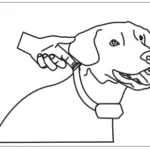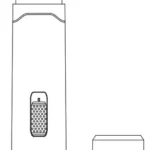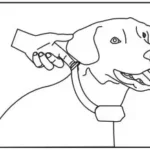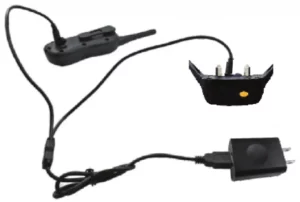
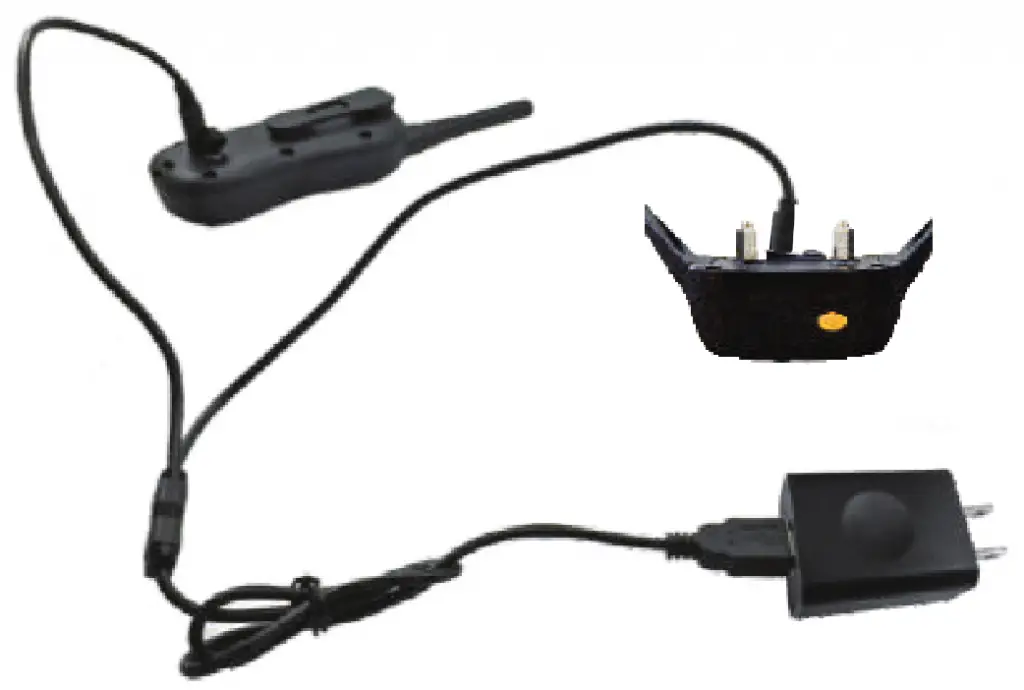
Remote Training Collar
operating and training guide
PLEASE READ THIS ENTIRE GUIDE BEFORE BEGINNING
Important Safeg lnfomation
 WARNING
WARNING
Not for use with aggressive dogs. Do not use this Product if your dog is aggressive, or if your dog is prone to aggressive behavior. Aggressive dogs can cause severe injury and even death to their owner and others. If you are unsure whether this product is appropriate for your dog, please consult your veterinarian or a certified trainer.
 CAUTION
CAUTION
Safety during on-leash training. It is vitally important that you and your dog remain safe while learning during on-leash training. Your dog should be on a strong leash, long enough for him to attempt to chase an object, but short enough for him not to reach a road or other unsafe area. You must also be physically strong enough to restrain your dog when he tries to chase.
CAUTION
Risk of skin damage. Please read and follow the instructions in this manual. Proper fit of the collar is important. A collar worn for too long or made too tight on the pet’s neck may cause skin damage. Ranging from redness to pressure ulcers; this condition is commonly known as bed sores.
- Avoid leaving the collar on the dog for more than 12 hours per day.
- When possible reposition the collar on the pet’s neck every 1 to 2 hours.
- Check the fit to prevent excessive pressure; follow the instructions in this manual.
- Never connect a lead to the electronic collar; it will cause excessive pressure on the contacts.
- When using a separate collar for a lead, don’t put pressure on the electronic collar.
- Wash the dog’s neck area and the contacts of the collar weekly with a damp cloth.
- If a rash or sore is found, discontinue use of the collar until the skin has healed.
- If the condition persists beyond 48 hours, see your veterinarian.
These steps will help keep your pet safe and comfortable. Millions of pets are comfortable while they wear stainless steel contacts. Some pets are sensitive to contact pressure. You may find after some time that your pet is very tolerant of the collar. If so, you may relax some of these precautions. It is important to continue daily checks of the contact area. If redness or sores are found, discontinue use until the skin has fully healed.
Components

Other Items You May Need
- Screwdriver
- Scissors
Main Features
 600M remote Training Range
600M remote Training Range
 User Expandable to a Tow-dog System
User Expandable to a Tow-dog System
 Tone, Vibration, and Shock Commands
Tone, Vibration, and Shock Commands
 16 Adjustable Progressive Intensity Levels for Vibration and Shock
16 Adjustable Progressive Intensity Levels for Vibration and Shock
 Blue Backlit LCD Indicating Intensity Level and Battery
Blue Backlit LCD Indicating Intensity Level and Battery
 2-hour Rapid Charging Lithium Polymer Battery
2-hour Rapid Charging Lithium Polymer Battery
 100% Waterproof for Receiver
100% Waterproof for Receiver
 Innovative Blind Operation with Touch Distinguishing Mode Buttons
Innovative Blind Operation with Touch Distinguishing Mode Buttons
Overview

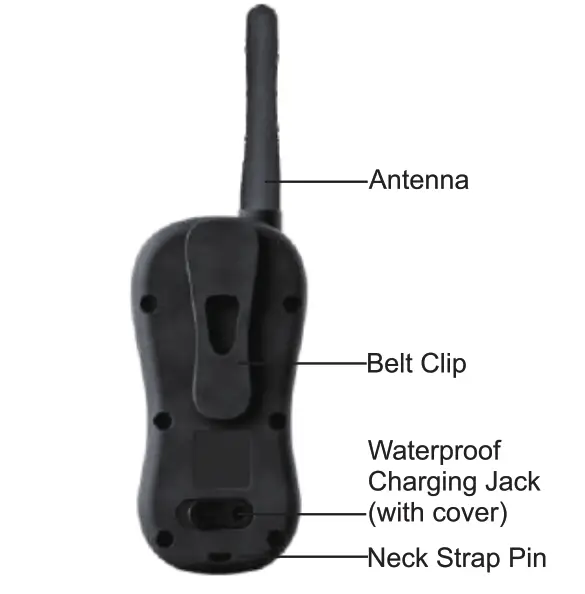
Transmitter
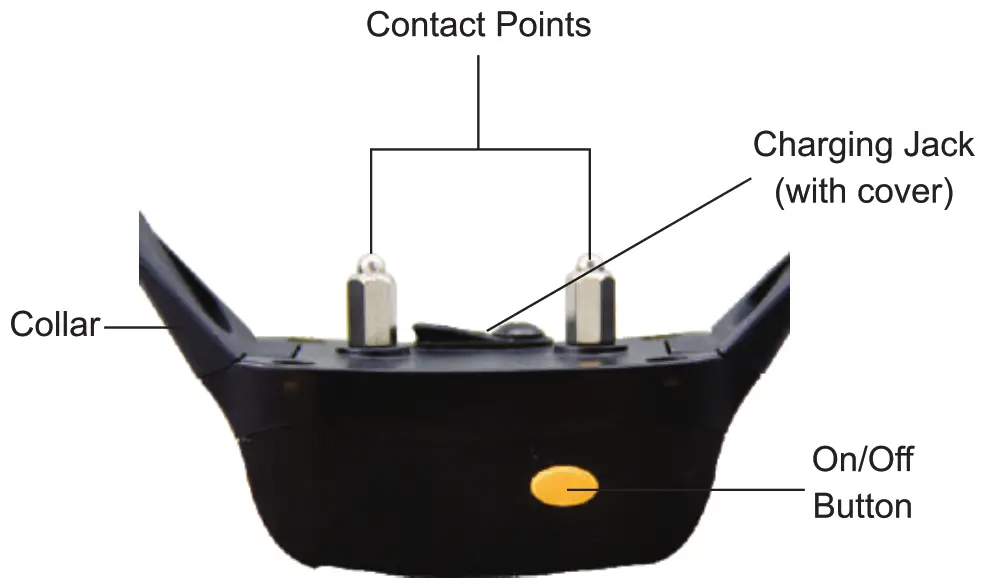
Receiver Collar
Operating Guide
Step 1.
How to turn the p-collar 620 on/of
To turn the Transmitter on
- To mount the antenna to the corresponding position of the transmitter tightly.
- Press any button on the Transmitter.
The blue backlight on the display stays on for approximately 30 seconds after a button press. After that with no button press, the blue backlight shuts off first, and if no button press with another five minutes, the display shuts off and the Transmitter goes into battery conservation mode. Pressing any button will turn the display back on.
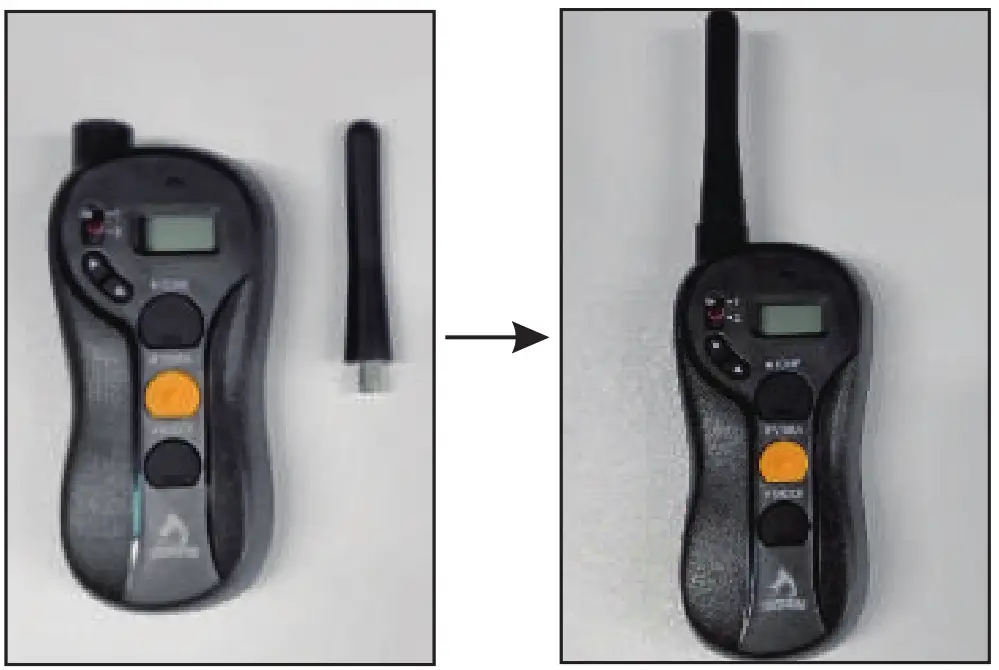
To turn the Receiver Collar on
- Press and hold the On/Off Button until the Green LED light comes on. (This takes approximately one ).
- Release the On/Off Button.
In normal mode, the Green LED will flash once every 5 seconds, indicating the Receiver Collar is on and ready to receive a signal from the Handheld Transmitter.
To turn the Receiver Collar off
- Press and hold the On/Off Button until the Red LED light shuts (This takes approximately three seconds.)
- Release the On/Off Button.
Note: To extend the life of the bakeries, turn the Receiver Collar off when it is not in use.
Step2
How the Transmiher buttons work
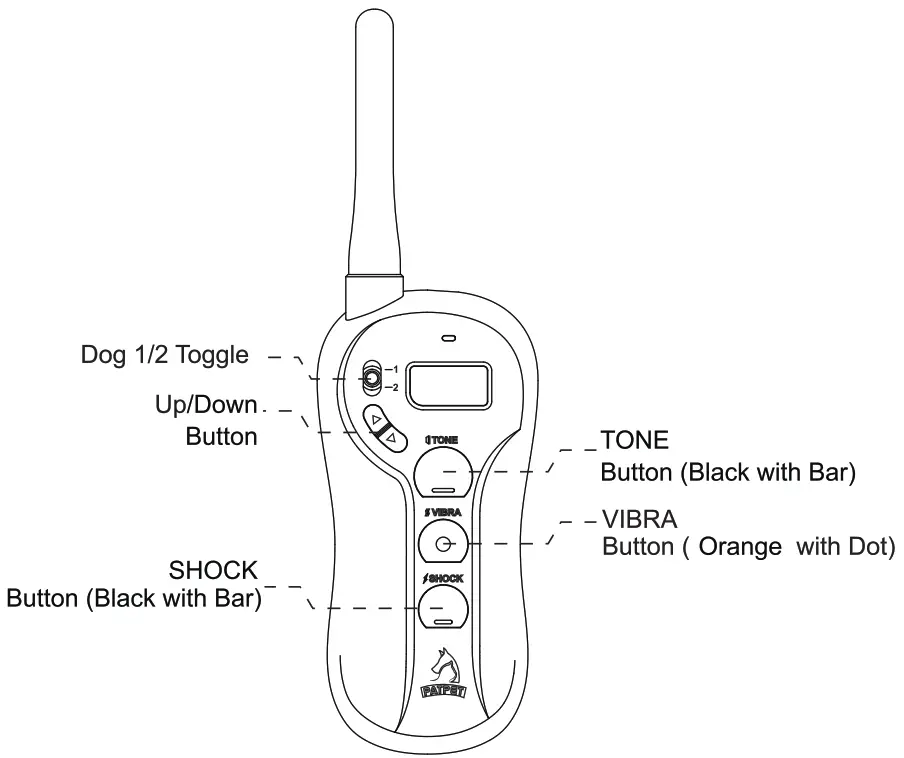
Tone Only Bu¥on (Black with Bar):
Sends an audible tone to the collar. No stimulation is delivered. Vibration Only Button(Orange with Dot) /Shock Only Button(Black with Bar):
Delivers vibration/shock through the Contact Points on the Receiver Collar at the level shown on the Digital Display. When held down for 10 consecutive seconds, the Transmitter will “time-out”, and vibration/shock cannot be delivered for 5 seconds. You must release and press the button again aXer the 5 second time-out period, before additional vibration/shock can be delivered.
Dog 1/2 Toggle Switch
Located on the upper left face of the Transmitter is a toggle switch, allowing a switch between Dog 1 and Dog 2.
Vibra/Shock Up Button (+): Increases vibration/shock Level by 1.
Vibra/Shock Down BuNon (-): Decrease vibration/shock Level by 1.
Step3
Collar fitting
The Receiver/Collar should be fitted so that the surgical stainless steel contact points press firmly against the dog’s skin. When properly fitted, you should be able to fit a finger or two snugly in between the collar and your dog’s skin. When properly fitted, the Receiver/Collar should not move on the dog. The best location for the Receiver/Collar box is either side of the dog’s windpipe.
A loose fit can allow the Receiver/Collar to move around on the dog’s neck. When this happens, the contact points may rub the skin and cause irritation. If the Receiver/Collar is too tight, the dogs may have difficulty breathing.
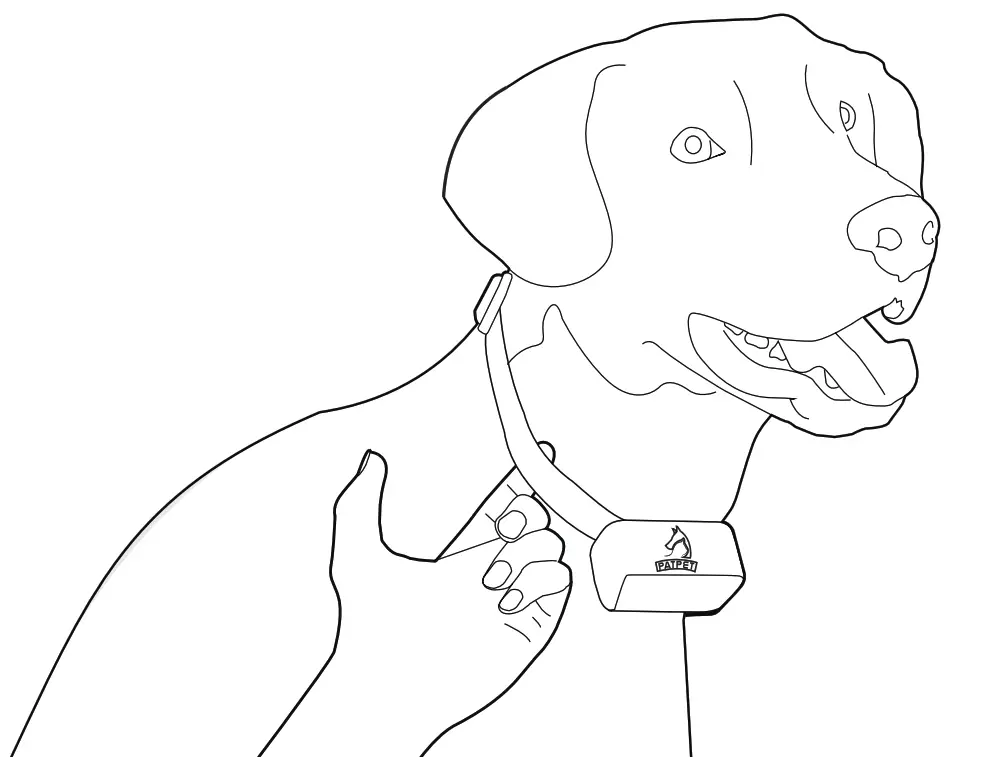
Step 4
How to find the best Vibration/Shock Level
The unit comes with Up and Down buttons to control the Vibration/Shock Level, with Level 1 being the lowest level and Level 16 being the highest. The level of Vibration/Shock best suited for your dog depends on your dog’s temperament and threshold for Vibration/Shock. Always start at the lowest level and work your way up. The appropriate level can be found when the dog responds to the Vibration/Shock with a mild reaction, such as a tensing of the neck muscles. The Vibration/Shock Level may vary depending on the training situation. When highly distracted, dogs will require a higher level of Vibration/Shock.
Step 5
To maximize the distance
The unit has a 600 meters range. The range may vary depending on the way the Transmitter is held. Hold the Transmitter away from your body to receive the greatest range. For maximum signal strength, keep the device properly charged.
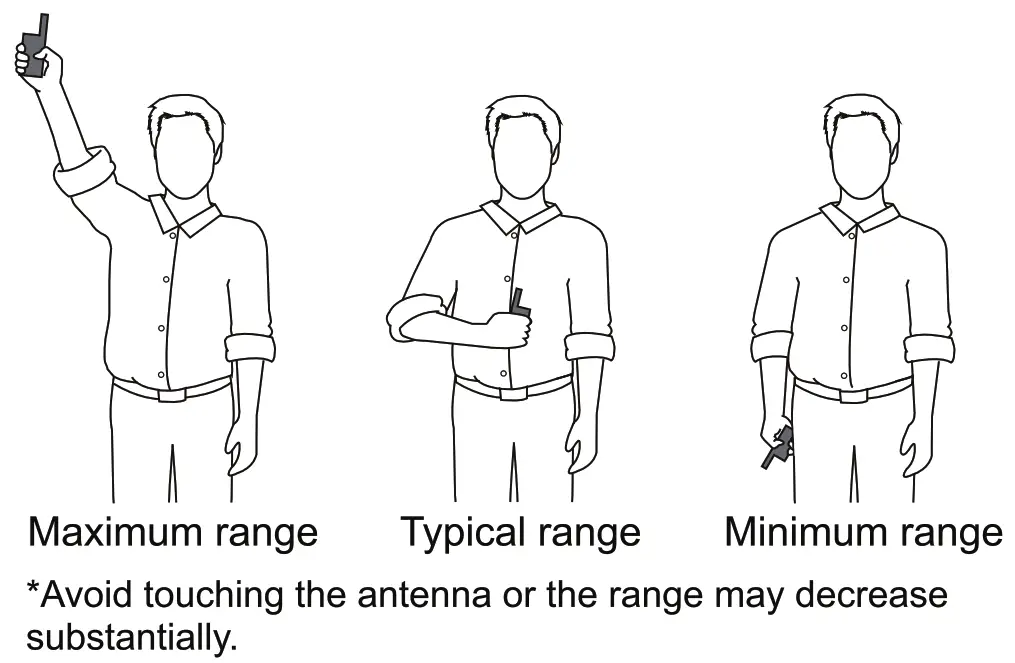 Step 6
Step 6
The LCD and LED indicator
 |
Indicates Vibration/Shock levels ranging from 1-16, and appears in the middle part. |
 |
Indicates the active dog receiver and appears in the left part. |
 |
Indicates battery’s power level. Note: The battery indicator will flash every second to indicate a low battery. |
Transmitter LED Indicator Light — Fun4ion and Response
| Button | Button Fun4ion | Transmitter Indicator Light Response |
| TONE (Black w/ Bar) | Delivers audible tone to collar | Red LED on for length of button press |
| VIBRA (Orange w/ Dot) | Delivers vibration to collar base on current level shown on Digital Display (vibration will time-out for 5 seconds if pressed continuously for 10 seconds and will reset after timeout period) | Red LED on for length of button press |
| SHOCK (Black w/ Bar) | Delivers shock to collar base on current level shown on Digital Display (shock will time-out for 5 seconds if pressed continuously for 10 seconds and will reset after timeout period) | Red LED on for length of button press |
| TONE and VlBRA Buttons held simultaneously | Transmits Pairing command to Receiver COllar | Red LED on for length of button press |
Receiver Indicator Light — Function and Response
| Receiver Collar Function | Green LED Response |
| Power on | Flashes once |
| Normal operation – Good battery | 1 flash every 5 seconds |
| Training tone | On length of TONE button press |
| In pairing position | Flashes once every second within 16 seconds |
| Pairing Complete | Flashes rapidly for five times |
| Charging Complete | On length of the charger connected |
| Receiver Collar Function | Red LED Response |
| Power off | On for 3 seconds |
| Normal operation – Low battery | Flashes rapidly |
| Vibration/Shock | On length of VIBRA/SHOCK button press |
| Charging | On length of charging within 2-3 hours |
Step7
Charging the battery
The unit uses Lithium-Polymer batteries.
- Charge the unit before using the unit for the first
- Do not charge the batteries near any flammable
- Fully charge the batteries if the unit is to be stored without use for a period of 3 months or
Recharge the unit if:
The indicator light on the collar is emitting a red color and flashes rapidly. The 3 bar indicator on the Transmitter LCD shows just 1 bar. The indicator light on the Transmitter or Receiver will not come on. The indicator light on the Transmitter or Receiver comes on momentarily when any of the Mode Buttons is pushed.
Battery Charging Procedure
NOTE: The unit has a partial charge when it leaves our facility, upon receipt of the collar, be sure to give it a 4-hour initial charge before the first use.
- Lift the rubber covers protecting the Transmitter/Receiver Collar Charging
- Connect the charger connectors to the Transmitter and Receiver Collar Charging Jack, and as shown
- Connect the USB port to the Charging
- Plug the charger into a standard wall
- Charge the unit for 4 hours for the first Recharges take only 2-3 hours.
Note: The Battery Indicator on the Transmitter will scroll and the indicator light in steady red while charging; and the Battery Indicator will become steady, and the LED Indicator Light flashes when fully charged.
The indicator light on the Receiver Collar will be in steady red while charging and the green light turned on when fully charged.
- When charging is completed, remove the charger

Step 8
How to pair the Remote Transmitter and Receiver Collar
If your Receiver Collar does not beep when the TONE Button of the Remote Transmitter is pushed, or if you feel the Receiver Collar is not responding to the Remote Transmitter, follow these steps to pair:
- With the Receiver Collar off your pet, turn the Receiver Collar Restart, press, and hold the On/Off Button until the Green LED flashes every second on the Receiver Collar. This continues for 16 seconds, within which pairing should be completed.
- Press and hold the TONE and VIBRA Button of the Remote Transmitter at the same time until the Green LED Light on the Receiver Collar flashes rapidly for 5 times, indicating pairing is
Two Dog System
NOTE: If you wish to add another Receiver Collar to the training system, extra Receiver Collars are available where you bought your unit.
Remote Transmitter
- Set the Toggle Switch to
- Turn on the Receiver Collar for Dog 2, press any Mode Buttons to verify
- If Dog 2 Receiver Collar does not Pairing may be needed. Repeat steps in How to pair the Remote Transmitter & Receiver Collar above.
Step 9
How to use the Test Light
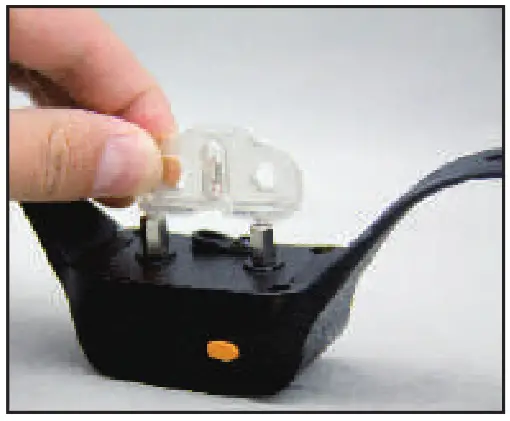
- Turn the Receiver Collar on.
- Hold the Test Light Contacts to the Contact to the Contact Points.
- Press the SHOCK Button on the Remote
- The Test Light will flash.
Note: At higher Shock Levels, the Test Light will flash brighter. - Turn the Receiver Collar off.
Save the Test Light for future testing. Note: If the Test Light does not flash, recharge the Receiver and re-test. If Test Light still does not flash, contact us for Customer Service.
Training Guide
General Tips
- Eliminate one misbehavior or teach one obedience command at a time. If you move too fast with training, your pet may become confused.
- Be consistent. Correct your pet every time he misbehaves.
- Unless you can supervise him, it is recommended that you restrict your pet from situations in which he has a history of misbehaving. However, setting up a situation as a training session can dramatically improve your chances of success.
- If your pet reacts to the tones by hiding or acting fearfully, redirect his attention to a simple and appropriate behavior, such as the “sit”
- Pets should be at least 6 months old before using the Training Collar.
- OnIy let responsible family members use the Training Collar. lt is not a toy!
- Other pets in hearing range will be a ected by the training tones.
Therefore, training sessions should be conducted out of hearing range of other pets.
 WARNING
WARNING
Never use the Remote Training Collar to correct or eliminate any form of aggressive behavior. We recommend you to consult your local veterinarian or professional trainer to determine if your pet might be aggressive. See page 3 for more information.
Frequently Asked Question |
|
| ls the Vibration/Shock safe for my pet? | While the Vibration/Shock is unpleasant, it is harmless to your pet. Electronic training devices require interaction and training from the owner to achieve desired results. |
| How old does my pet have to be before using the Remote Training Collar? | Your pet should be able to recognize basic obedience commands such as “Sit” or “Stay”. Pets should be at least 6 months old before using the Training Collar. |
| Once my pet is trained and has been obeying my œmmands, will he have to œntinue to wear the Reæiver Collar? | Probably not. You may need to reinforce training with the Receiver Collar from time to time. |
| Is the Receiver Collar waterproof? | Yes. |
| Will I get exa4ly 600 meters of range with the Remote Training CollaP | The range of the Remote Training will vary according to terrain, weather, vegetation, as well as transmission from other radio devices. See “To maximize the distance” for tips on maximizing your range. |
| How long can I œntinuously deliver Vibration/ Shock to my pet? | The maximum amount of time you can press the Vibration/Shock Button and deliver Vibration/Shock to your pet continuously is 10 seconds. After this, there’s a time-out and Vibration/Shock cannot be delivered for 5 seconds. After the 5 second time-out period, Button can be pressed and Vibration/Shock can be delivered again. |
Troubleshooting |
|
| My pet does not respond when I press a button. | • Make sure the Receiver Collar has been turned on. • If your range has reduced from the first time you used the Remote Training Collar, the battery(s) may be low in either the Remote Transmitter or Receiver Collar. • Terrain, weather, vegetation, transmission from other radio devices, and many other factors can impact the amount of range you have with the unit. • Test the Receiver Collar. See “How to use the Test Light” for details. • Increase the Vibration/Shock Level. Refer to “How to find the best Vibration/Shock Level” for more information. • Make sure the Receiver Collar’s Contact Points are placed snugly against your pet’s skin. Refer to “Collar fitting” for more information. |
| The Receiver Collar will not turn on. | • Make sure the Receiver Collar has been charged. For the initial charge, be sure to charge it for 4 hours. Subsequent charges only take 2-3 hours. |
| The Receiver Collar is not responding to the Remote Transmitter. | • Verify the Receiver Collar is on.
• if the Indicator Light does not come on when any button is pressed on the Transmitter, ensure that the batteries are fully charged. • If the first two solutions did not resolve your problem, see “How to pair the Remote Transmitter & the Receiver Collar”. |
Warranty
1-Year Limited Lifetime Warranty
The original purchaser for this unit is provided with a 1-YEAR WARRANTY.
The warranty begins from the date of purchase. For the first year, coverage is for both Parts and Labor on warranty repair services.
Accessories such as chargers, splitter cables, antennas, straps, and batteries are covered for the first year only. After the first year, the Limited Lifetime Warranty covers Parts only and does not cover Labor Fees and Accessories. All shipping fees incurred, the cost of Accessories after the first year, and Labor fees associated with out-of-warranty repair work, are the customer’s responsibility.
Labor fees will be variable depending on the extent of the work required. The Limited Lifetime Warranty expires 5 years after a model is discontinued from production.
To Qualify for the Warranty
All products must provide proof of purchase is required to initiate repair work under warranty. We strongly recommend keeping the original receipt. If proof of purchase is not available at the time of service, we will estimate the age of the unit by the serial number. Serial number estimates can differ from the actual purchase date. A serial number estimate is the only method of determining an approximate date of purchase without proof of purchase.
Not Covered Under Warranty
We DO NOT offer a warranty for products that have been bought secondhand or as a resold product. We DO NOT replace defective units or provide refunds for products purchased from us after 30 days from the date of purchase.
Issues of replacement and refunds on units purchased less than 30 days from an authorized dealer must be addressed to the dealer directly. If the products purchased from an authorized dealer are after 30 days from the date of purchase, please send the units to us for service and repair. We DO NOT cover the cost of repairs and replacements due to misuse by the owner or dog, improper maintenance, and/or lost units. Any water damage on the Water Resistant Transmitters and the Water Resistant Receivers of our product series will not be covered. All replacement costs for either the transmitter or receiver will be the owner’s responsibility.
The warranty is void if the unit has been altered or an unauthorized person has damaged the unit while attempting repair work. Battery replacement by the customer during the first year of the Limited Lifetime Warranty is not recommended. If the customer chooses to replace the batteries, any damage to the unit during the change-out by the owner will void the warranty. We reserve the right to retain and discard any parts or accessories that have been found damaged upon replacement and repair.
Procedure for Repair Work
If the unit is malfunctioning, please refer to the “Troubleshooting Guide” in the Operating and Training Guide before sending it back for Service. The cost of shipping products under warranty back is the customer’s responsibility. We are not responsible for units damaged or lost in transition. We are not responsible for loss of training time or inconvenience while the unit is in for repair work. We do not provide loaner units or any form of compensation during the repair period.
A copy of the sales receipt showing the purchase date may be required before warranty work is initiated. Please include a brief explanation outlining the problem and include your name, address, city/state/zip code, daytime phone number, evening phone number, and email address.
Compliance
FCC – USA
This device complies with part 15 of the FCC Rules. Operation is subject to the following two conditions: (1) This device may not cause harmful interference, and (2) this device must accept any interference received, including interference that may cause undesired operation.
CAUTION: Modification or changes to this equipment not expressly approved by Patpet Technology Co., Ltd may void the user’s authority to operate the equipment.
NOTE: This equipment has been tested and found to comply with the limits for a Class B digital device, pursuant to part 15 of the FCC Rules. These limits are designed to provide reasonable protection against harmful interference in a residential installation. This equipment generates, uses, and can radiate radio frequency energy and, if not installed and used in accordance with the instructions, may cause harmful interference to radio communications. However, there is no guarantee that interference will not occur in a specific installation. If interference does occur to radio or television reception, which can be determined by turning the equipment off and on, the user is encouraged to try to correct the interference by one or more of the following measures:
- Reorient or relocate the receiving antenna.
- Increase the separation between the equipment and the receiver.
- Connect the equipment to an outlet on a circuit different from that to which the receiver is connected.
- Consult customer care, the dealer, or an experienced radio/TV technician for help.
Reference Size for DiXerent Dogs
| Size | Neck (in) | Chest Measurement (in) | Back Length (in) | Type |
| Mini | 7.8-8.6 | 9.8-11.8 | 7.5 | Chihuahua, Yorkshire Terrier |
| Small | 7.8-9.5 | 11.4-14.2 | 9 | Chihuahua, Yorkshire Terrier, Poodle, Pomeranian |
| Medium | 9 11 | 13.7-16.5 | 11 | Maltese Dog, Shih Tzu |
| Large | 10.6-12.2 | 16.2-18.5 | 12.2 | Miniature Schnauzer,
Pekingese |
| Large | 11.8-13.4 | 18.1-20.8 | 13.8 | Schnauzer, English Cocker Spaniel |
| Large | 13-14.5 | 20.5-23.2 | 15.7 | Beagle |
| Huge | 17-18.9 | 30-33 | 23.6 | Husky |
| 18.5-20.5 | 34.6-38.2 | 25.6 | Labrador Retriever | |
| 21.6-24.4 | 36.2-39.3 | 27.5 | Golden Retriever, Old English Sheepdog |
Reference Weight for Dogs
Large Dog (Body height above 24 inch, Weight above 88 lbs)
Medium Dog (Height 16-24 inch, Weight 24.2-66 lbs)
Small Dog (Height 10-16 inch, Weight 8.8-22 Ibs)
Mini Dog (Height under 10 inch, Weight under 8.8 lbs)

Shenzhen Patpet Technology Co, Ltd
 https://patpet.com/
https://patpet.com/
 Become a dealer: [email protected]
Become a dealer: [email protected]
 After-service: [email protected]
After-service: [email protected]
 @PatpetDogCollar
@PatpetDogCollar
 Youtube Video Guide
Youtube Video Guide
![]()

